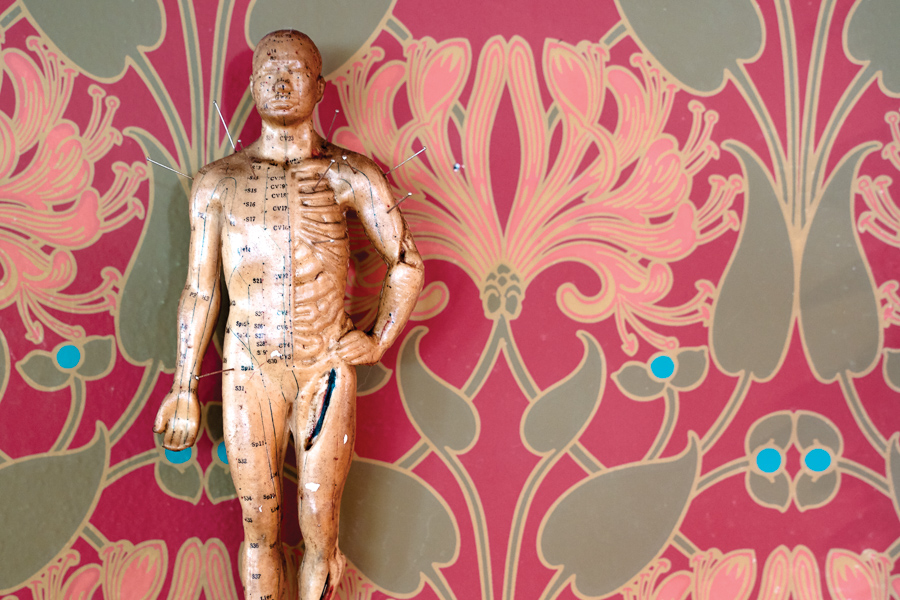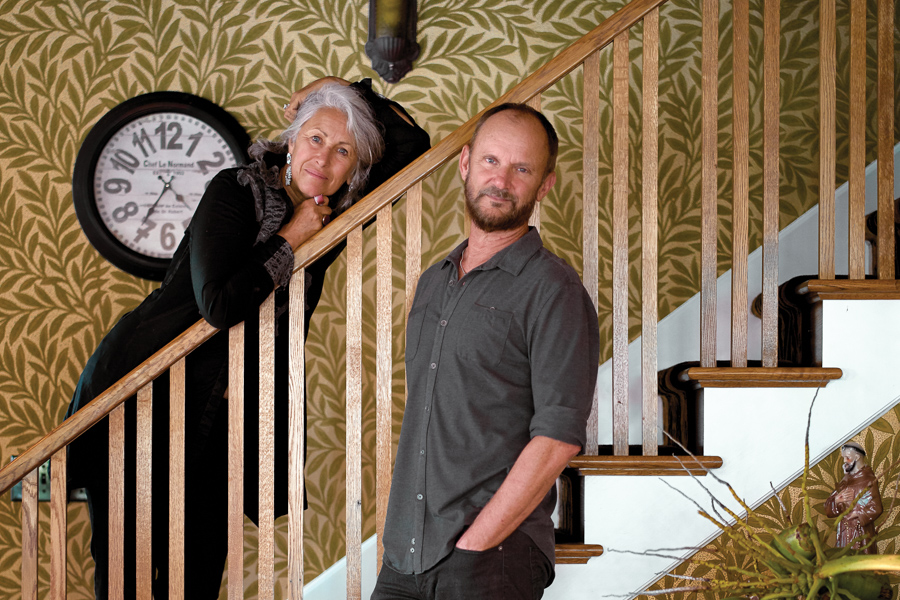DAVID MCGOUGH AND LIZZIE VANN FOUND EACH OTHER in 2013 and a year later, found a quaint corner property right on Bimini Bay in Anna Maria Island. The house became a passion project—to rescue, renovate and redesign a home that melded both their styles and adorations. David’s photographic background in NYC—growing up in the heyday of rock and roll and no stranger to photographing the likes of Ozzy Osbourne and Madonna—garnered a hardbound publication of his celebrity paparazzi/portrait photography before retiring to Florida. And Lizzie, being the British businesswoman that she modestly is—despite being personally honored by the Queen of England herself—left behind an enterprise built of innovative child health products and organic baby foods to jump the pond to Florida for slower, sunnier days. What manifested was a creatively colorful, historical and chaotically pleasing project of venerable design.

PHOTO BY WYATT KOSTYGAN.
"The theme of our home was to preserve and restore our heritages—to re-use instead of re-build,” says Lizzie. “The past is a treasure trove.” Celebrating true craftsmanship, hand-wrought construction and intricate details, her inspiration came principally from William Morris, a British textile designer, poet, novelist, translator and socialist activist. He was also a major contributor to the revival of traditional British textile arts and methods of production, often associated with the British Arts & Crafts Movement in the late 1800s. Lizzie found splendor in designing the house like its own time-warped arts-and-crafts project. And Morris’ ideals advocating economic and social reform over industrialization can be seen throughout every square-inch. The tucked-away dwelling leaves a lasting impression, with as much of a utilitarian
purpose as an optical allure.

PHOTO BY WYATT KOSTYGAN.
“Have nothing in your house that you do not know to be useful, or believe to be beautiful.” -William Morris.

PHOTO BY WYATT KOSTYGAN.
“Morris rejected industrial manufacturing in favor of returning to hand-crafting, making artisans into artists, creating affordable, daily-use art with no artistic hierarchy,” says Lizzie. Wallpapers that cover every square inch of the home are slabbed on with a visually stimulating appeal, while simultaneously doing their part in covering the plain, neutral walls hiding underneath. Sourced by Bradbury Art Wallpapers, the company specializes in 19th and 20th-century wallpapers and fabrics, reproducing historic patterns and faithfully reinterpreting them with alternate colorings or patterns. Each motif offers a glimpse into the styles of that time period. The living room’s foliate ‘Arbor’ wallpaper with a Chrysanthemum border was designed by Bruce James Talbert, the influential leader of the 1860s British Aesthetic Movement. The ‘Honeysuckle’ hallways are enveloped in wallpaper designed by William Morris’ daughter May Morris, who became well known for her free-form embroidery, artisanal jewelry and ceramics.

PHOTO BY WYATT KOSTYGAN.
The interior color palette of sage, golds, pomegranate and russet are picked up in the Persian area rugs, Art Deco lamps and drapes of Old World-inspired textiles. The house purposefully took on a Victorian and Northern England architecture style, with touches of medieval, romantic, spiritual and folk design. Quarter-sawn oak doors and trim work, vintage hardware, tin ceilings, mosaic parquet flooring, natural tigerwood countertops, built-in bookshelves and a mahogany fireplace rescued from a 1920s derelict house are all evocative of the distinct features of a trus craftsman Though, Lizzie and David were sure to weave personal touches throughout their museum/gallery abode. David’s instruments lie around the “music room,” while his life-size photography is framed on the walls. Lizzie’s lifelong-curated collection of paintings, hand-crafted sculptures, pottery and antique clocks decorate every nook and cranny. Ultimately, the intriguing pair not only collided their two worlds but created an eclectic centerfold of “restoration, happiness and a place for friendship.”










